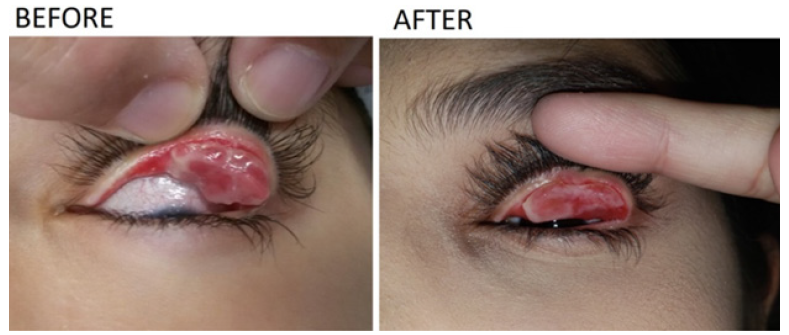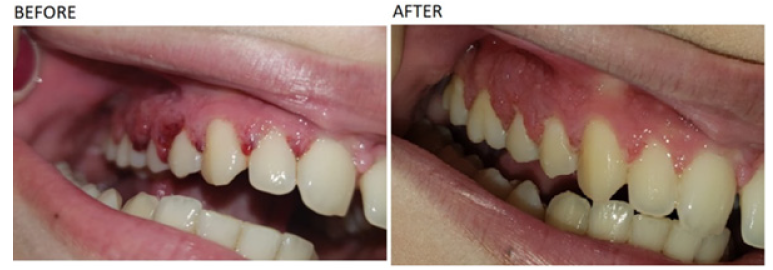Case Report 
 Creative Commons, CC-BY
Creative Commons, CC-BY
Experimental Treatment that Showed Great Improvement in the Clinical Condition of a Patient with Ligneous Gingivitis Caused by Plasminogen Deficiency: Case Report
*Corresponding author:Mariana Granito, Universidade Estácio de Sá Science and Nutrition department Teresópolis, RJ Brazil
Received:March 14, 2023;Published:April 17, 2023
DOI: 10.34297/AJBSR.2023.18.002488
Abstract
Plasminogen is an enzyme that has an important function in homeostasis, and in wound healing. It is linked to fibrin dissolution, and therefore, of thrombus. It has an important role in macrophage recruitment during inflammatory responses. It was started an experimental treatment with an enzyme called Nattokinase. It is a protease type enzyme = Serine protease (serine endopeptidase) derived from Bacillus subtilis. Composed by total residues of 275 amino acids with a molecular weight of 27.7 kDa, being considered the main functional ingredient of natto, a traditional fermented soybean food in japan. The patient has been followed up for 3 years with the same NATTO dosage. During this period, we could observe that the clinical symptoms are under control. In the ophthalmological part, we observed a reduction in redness, swelling, sensitivity/pain and local mucus production during the use of the drug. The use of nattokinase might be a palliative treatment, with almost instantaneous effects (on clinical findings). The benefits started to show after 4 days of use (the improvement of symptoms was already apparent), however, if discontinue the drug, was noted reappearance of symptoms in less than a week or even in a day.
Keywords: Ligneous gingivitis, Plasminogen deficiency, Nattokinase
Introduction
Plasminogen is an enzyme that has an important function in homeostasis, and in wound healing [1]. It is linked to fibrin dissolution, and therefore, of thrombus. It has an important role in macrophage recruitment during inflammatory responses, in invasion and metastasis of tumors cells, wound-healing, tissue remodeling, neurite outgrowth and with skeletal muscle tissue [2]. Serum rates usually are expected to be between 70–140%. Plasminogen deficiency is a rare autosomal recessive disease. It is congenital [2,3] and is possible to find people from the patient family with activity levels of plasminogen rate <50%, without the presence of ligneous lesions. This highlights the variability in presentation of this disorder and makes tight correlation of levels with hard clinical symptoms [1]. Patients with plasminogen deficiency usually have a very reduced wound-healing capability, mainly in mucous membranes, as conjunctiva or gum1, that is why lesions in these types of area are usually rich in fibrin (due to lack of proteolytic capacity) [3,4]. One consequence of plasminogen deficiency is Ligneous conjunctivitis. Clinical signs are usually: Chronic lacrimation, conjunctival hyperemia, low immunity, lesions conjunctival membrane and/or in other mucosal tissues. It shows some pseudomembranes growth, that are deeply stuck in the conjunctiva of the eyelid. Their removal tends to cause bleeding because the area is very vascularized [5]. Besides the ocular region, other mucous membranes may be involved, such as oral, nasopharyngeal, gum, trachea, endometrium and vagina [6]. Several cases of ligneous conjunctivitis and/or gingivitis were found in association with plasminogen deficiency type I [6].
We already have some options of treatments are available in literature. Was noticed reports of: surgical procedures; use of topical plasmin or plasminogen in the area; administration of immunosuppressive agents such as cyclosporine and heparin; use of fresh frozen plasma systemically and topically; autologous serum (local application of plasma from a donor with regular serum level of plasminogen); and replacement therapy with human Glu-plasminogen [1-7]. Treatments that usually are costly, highly invasive, not easy to reproduce and do not cure the disease [6]. There are also dietary proposals based on specific nutrients and the use of bioactive compounds that have been shown a little effective, but those require excellent patient compliance for results to be achieved [7,8].
Materials and Method
A case report has been studied for 21 years. Patient, female, Brazilian, diagnosed with ligneous conjunctivitis with deficiency of plasminogen (Functional Plasminogen 20%; Reference: 70% to 140%) at age 3, that showed excessive production of secretions in the mucosa of the eyelid, with growth of Ligneous Pseudomembrane (PL). Since the beginning of the lesions, she did several surgical procedures for the removal of the PL, which growth were recurrent weeks after removal. With 6 years old, she had initiated a topical plasma treatment (autologous serum), where paternal blood was extracted and centrifuged, and the decanted plasma was frozen in sterile dropper bottles for topical use. Initially it presented relief effects, but over time, its benefits were no longer seen. And, with the difficulty in finding a place that would produce the serum properly, the family chose to discontinue the treatment, since they no longer saw positive results after 4 years of use. At the age of 12, she had already tried all treatments found in the literature described in this article, without positive results. All types of treatment were discontinued over time due to the lack of results. At the age of 14, was noticed the growth of lesions in the gum area (ligneous gingivitis), causing chronic inflammation, reddish and wounds, bleeding during tooth brushing process and an intense smell, characteristic of cell necrosis. At the age 15, nutritional therapy 15 was tested with regular results, however the patient was unable to adapt to the proposed dietary restrictions. The use of conventional toothpaste was suspended, and the use of vegan excipient-based toothpaste + Matricaria chamomilla or Curcuma longa L. and mint extract was started. Gum lesions decreased but did not improve the appearance of necrosis and the intense smell, as the incidence of bleeding.
So, at the age 18 was started an experimental treatment with an enzyme called Nattokinase. It is a protease type enzyme = Serine protease (serine endopeptidase) derived from Bacillus subtilis. Composed by total residues of 275 amino acids with a molecular weight of 27.7 kDa, being considered the main functional ingredient of natto, a traditional fermented soybean food in japan. Studies indicate that this enzyme could decrease the concentration of fibrin and possibly increase the endogenous production of plasmin [9] and reduction of fibrinogen. This reduction would be considered important because it would have a similar function to plamisminogen [10]. Before starting the treatment, blood tests were done. The results will be indicated in: values obtained (references). Therapy was initiated with encapsulated pills of nattokinase 150mg/day (which correspond to approximately 3,000 fibrinolysis units), taken in the evening. No changes in lifestyle, dietary habits or use of complementary drugs were associated. After three months of treatment, the patient was reevaluated.
Results and Discussion
The plasminogen was 32% (70% to 140%) and fibrinogen 401mg/dL (200 to 400mg/dL), hemosedimentation speed: 21mm (20mm) (this last on was used as an inflammation maker). As for the clinical findings, the PL of the conjunctiva were smaller, lighter and did not present any type of secretion or mucus (Figure 1). As for the gums, there was no more bleeding during tooth brushing, as well as no signs of necrosis or intense smell. The gum showed just small lesions of pale granulomas and without pain (Figure 2). When we evaluate the serum date, the presented alteration in the lipid part was not find anymore: The plasminogen was 33% (70% to 140%) and fibrinogen 336mg/dL (200 to 400mg/dL), hemosedimentation speed: 13mm (20mm). The patient has been followed up for 3 years with the same Nattokinase dosage. During this period, we could observe that the clinical symptoms are under control it is possible to observe a reduction in redness and improvement in sensitivity. The gingiva was no longer inflamed and showed no signs of necrosis, as shown in image 1. Bad breath and pain when chewing reduced. The symptoms reappear one day after discontinuing the drug (three attempts to discontinue it have been made over the last 3 years).
Conclusion
The use of nattokinase might be a palliative treatment, with almost instantaneous effects (on clinical findings). The benefits started to show after 4 days of use (the improvement of symptoms was already apparent), however, if discontinue the drug, was noted reappearance of symptoms in less than a week or even in a day. This is certainly an important finding in the literature. It was noticed a great improvement in the patient’s quality of life, with reduced inflammation and mucus production (mainly in the gums). In addition, the results are exciting, as it is a low-cost treatment, simple to reproduce and easy patient compliance. Further studies are needed to validate the treatment, but this article certainly suggests a new innovative possibility, which has never been evaluated before.
Author Contribution Statement
Mariana Granito is the only author, being responsible for observing the case, writing and revising the manuscript.
Acknowledgement
None.
Conflict of Interest
The author report no conflicts of interest.
References
- Mehta R, Shapiro AD (2008) Plasminogen deficiency. Haemophilia 14(6): 1261-1268.
- Cohen J, Cohen S, Cymberknoh MC, Gross M, Hirshoren N, et al. (2012) Laryngeal obstruction in congenital plasminogen deficiency. Pediatr Pulmonol 47(9): 923-925.
- Shapiro AD, Nakar C, Parker JM, Albert GR, Moran JE, et al. (2018) Plasminogen replacement therapy for the treatment of children and adults with congenital plasminogen deficiency. Blood 131(12): 1301-1310.
- Schuster V, Hugle B, Tefs K (2007) Plasminogen deficiency. J Thromb Haemost 5(12): 2315-2322.
- Tefs K, Gueorguieva M, Klammt J et al. (2006) Molecular and clinical spectrum of type I LETTERS TO THE EDITORS - Haemophilia (2015), 21, e122-e150 © 2015 John Wiley & Sons Ltd plasminogen deficiency: a series of 50 patients. Blood 108(9): 3021-3026.
- El-Darouti M, Zayed AA, El Kamah GY, Mostafa MI (2009) Ligneous conjunctivitis with oral mucous membrane involvement and decreased plasminogen level. Pediatr Dermatol 26(4): 448-451.
- GRANITO M, SCHMIDT B (2015) Orthomolecular nutritional therapy for plasminogen deficiency: report of a case that showed positive results. Haemophilia 21(2): e122-e150.
- GRANITO M, FERREIRA JM (2016) Nutritional treatment for leagnous conjuntivitis: case report and literature review and case report. Rev bras oftalmol 75(6): 476-480.
- Fujita M, Hong K, Ito Y, Fujii R, Kariya K, et al. (1995) Thrombolytic effect of nattokinase on a chemically induced thrombosis model in rat. Biol Pharm Bull 18(10): 1387-1391.
- Kim JY, Gum SN, Paik JK, Lim HH, Kim KC, et al. (2008) Effects of nattokinase on blood pressure: a randomized, controlled trial. Hypertens Res 31(8): 1583-1588.





 We use cookies to ensure you get the best experience on our website.
We use cookies to ensure you get the best experience on our website.